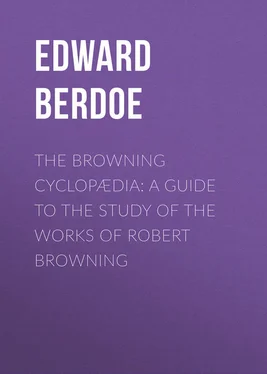Edward Berdoe - The Browning Cyclopædia - A Guide to the Study of the Works of Robert Browning
Здесь есть возможность читать онлайн «Edward Berdoe - The Browning Cyclopædia - A Guide to the Study of the Works of Robert Browning» — ознакомительный отрывок электронной книги совершенно бесплатно, а после прочтения отрывка купить полную версию. В некоторых случаях можно слушать аудио, скачать через торрент в формате fb2 и присутствует краткое содержание. ISBN: , Жанр: foreign_antique, foreign_prose, на английском языке. Описание произведения, (предисловие) а так же отзывы посетителей доступны на портале библиотеки ЛибКат.
- Название:The Browning Cyclopædia: A Guide to the Study of the Works of Robert Browning
- Автор:
- Жанр:
- Год:неизвестен
- ISBN:http://www.gutenberg.org/ebooks/36734
- Рейтинг книги:4 / 5. Голосов: 1
-
Избранное:Добавить в избранное
- Отзывы:
-
Ваша оценка:
- 80
- 1
- 2
- 3
- 4
- 5
The Browning Cyclopædia: A Guide to the Study of the Works of Robert Browning: краткое содержание, описание и аннотация
Предлагаем к чтению аннотацию, описание, краткое содержание или предисловие (зависит от того, что написал сам автор книги «The Browning Cyclopædia: A Guide to the Study of the Works of Robert Browning»). Если вы не нашли необходимую информацию о книге — напишите в комментариях, мы постараемся отыскать её.
The Browning Cyclopædia: A Guide to the Study of the Works of Robert Browning — читать онлайн ознакомительный отрывок
Ниже представлен текст книги, разбитый по страницам. Система сохранения места последней прочитанной страницы, позволяет с удобством читать онлайн бесплатно книгу «The Browning Cyclopædia: A Guide to the Study of the Works of Robert Browning», без необходимости каждый раз заново искать на чём Вы остановились. Поставьте закладку, и сможете в любой момент перейти на страницу, на которой закончили чтение.
Интервал:
Закладка:
“God’s in His heaven, All’s right with the world!”
He heard it as a young man, he hears it as he nears the dark river, the conviction had never left his soul for a moment in all the length of intervening years. Asolo will be a pilgrim spot for Browning lovers. The Catherine Cornaro referred to was the wife of King James II., of Cyprus; his marriage with this Venetian lady of rank was designed to secure the support of the Republic of Venice. After his death, and that of his son James III., Queen Catherine felt she was unable to withstand the attacks of the Turks, and was induced to abdicate in favour of the Republic of Venice, which in 1487 took possession of the island. Catherine was assigned a palace and court at Asolo, as already mentioned. Her palace was the resort of the learned and accomplished men and women of Venice, famous amongst whom was her secretary, Cardinal Pietro Bembo, the celebrated author of the History of Venice , from 1487 to 1513, and a number of essays, dialogues, and poems. His dialogue on Platonic love is entitled Gli Asolani . He died in 1547. When Queen Catherine settled in her beautiful castle of Asolo, she could have found little cause to regret the circumstances which led her from her troubled kingdom of Cyprus to the idyllic sweetness of her later life. Surrounded by her twelve maids of honour and her eighty serving-men, her favourite negress, her parrots, apes, peacocks, and hounds, her peaceful life passed in ideal pleasantness. But the wealth and luxury of her surroundings did not make her selfish, or unconcerned for the welfare of her little kingdom. In all that concerned the happiness and well-being of her people she was as deeply interested as the monarchs of more important states. She opened a pawnbroking bank for the poor, imported corn from Cyprus and distributed it, and appointed competent officials to settle the complaints and difficulties of her subjects. She lived for her people’s welfare, and won their affections by her goodness and grace. For twenty years she lived at Asolo, leaving it on only three occasions: to visit her brother in Brescia; to walk to Venice across the frozen lagoon; and once when troops occupied her little town. She died then, at Venice, on July 10th, 1510, and was buried by the republic of the city in the sea, with its utmost magnificence. The fate could scarcely have been called cruel which gave a royal residence amid scenery such as Asolo can boast, under such conditions as blessed the later years of good Queen Catherine.
At the Mermaid.The Mermaid Tavern, in Cheapside, was the favourite resort of the great Elizabethan dramatists and poets. Raleigh’s Club at the Mermaid was the meeting-place of Shakespeare’s contemporaries, where he feasted with Raleigh, Ben Jonson, Beaumont and Fletcher, Ford, Massinger, Donne, Drayton, Camden, Selden, and the rest. “At this meeting-place of the gods,” says Heywood, in his Hierarchy of Angels : —
“Mellifluous Shakespeare, whose enchanting quill
Commanded mirth or passion, was but Will ,
And famous Jonson, tho’ his learned pen
Be dipt in Castaly, is still but Ben .”
Mr. Browning introduces us to Shakespeare protesting that he makes no claim and has no desire to be the leader of a new school of poetry. In the person of Shakespeare Mr. Browning tells the world that if they want to know anything about him they must take his ideas as they are expressed in his works, not seek to pry into his life and opinions behind them. His works are the world’s, his rest is his own. He protests, too, that when he utters opinions and expresses ideas dramatically they are not to be snatched at by leaders of sects and parties, and bottled as specimens for their museums, or used to give authority to their own pet principles. He does not set open the door of his bard’s breast: on the contrary, he bars his portal, and leaves his work and his inquisitive visitors alike “outside.” Notwithstanding this emphatic declaration, it is probable that few great poets have opened their hearts to the world more completely than Mr. Browning: it is as easy to construct his personality from his works as it is to reconstruct an old Greek temple from the sculptured stones which are scattered on its site. All Mr. Browning’s characters talk the Browning tongue, and are as little given to barring their portals as he to closing the door of his breast. This fact must not, of course, be unduly pressed. The utterances of Caliban are not to be put on the same level as the thoughts, expressed a hundred times, which justify the ways of God to man. Having declared himself as determined to let the public have no glimpse inside his breast, in Stanza 10 be proceeds to admit us to his innermost soul, in its joy of life and golden optimism. It is as perfect a picture of the poet’s healthy mind as he could possibly have given us, and is an earnest deprecation of the idea that a poet must necessarily be more or less insane. Notes. — Oreichalch (7), a mixed metal resembling brass – bronze. “ Threw Venus ” (15): in dice the best cast (three sixes) was called “Venus.” Ben Jonson tells us that his own wife was “a shrew, yet honest.”
Austin Tresham.Gwendolen Tresham’s betrothed, in A Blot in the ’Scutcheon . He is next heir to the earldom.
Azoth( Paracelsus ). The universal remedy of Paracelsus, in alchemy. The term was applied to mercury, which was supposed to exist in every metallic body, and constitute its basis. The Azoth of Paracelsus, according to Mr. Browning, was simply the laudanum which he had discovered. The alchemists by Azoth sometimes meant to express the creative principle of nature. As “he was commonly believed to possess the double tincture, the power of curing diseases and transmuting metals,” as Mr. Browning explains in a note to the poem, the expression is often difficult to define precisely, as indeed are many of the terms used by alchemists.
Azzo.Lords of Este ( Sordello ): Guelf leaders. The poem is concerned with Azzo VI. (1170-1212), who became the head of the Guelf party. During the whole lifetime of Azzo VI. a civil war raged almost without interruption in the streets of Ferrara, each party, it is said, being ten times driven from the city. Azzo VII. (1205-64) was constantly at war with Eccelino III. da Romano, who leagued himself with Salinguerra. Azzo married Adelaide, niece of Eccelino, and died 1264. ( Encyc. Brit. )
Bad Dreams.( Asolando. ) I. In the first dream the lover sees that the face of the loved one has changed: love has died out of the eyes, and the charm of the look has gone. Love is estranged, for faith has gone. With a breaking heart the lover can say love is still the same for him. II. A weird dream of a strange ball, a dance of death and hell, where, notwithstanding harmony of feet and hands, “man’s sneer met woman’s curse.” The dreamer creeps to the wall side, avoiding the dance of haters, and steps into a chapel where is performed a strange worship by a priest unknown. The dreamer sees a worshipper – his wife – enter, to palliate or expurgate her soul of some ugly stain. How contracted? “A mere dream” is an insufficient excuse. The soul in sleep, free from the disguises of the day, wanders at will. Perhaps it may indeed be that our suppressed evil thoughts – thoughts that, kept down by custom, conventionality, and respect for public opinion, never become incarnate in act – walk at night and revel in unfettered freedom, as foul gases rise from vaults and basements when the house is closed at night, and the purifying influences of the light and air are excluded. III. Is a dream of a primeval forest: giant trees, impenetrable tangle of enormous undergrowths, where lurks some brute-type. A lucid city of bright marbles, domes and spires, pure streets too fine for smirch of human foot, its solitary traverser the soul of the dreamer; and all at once appears a hideous sight: the beautiful city is devoured by the forest, the trees by the pavements turned to teeth. Nature is represented by the forest, Art by the city and its palaces. Each in its place is seen to be good and worthy, but when each devours the other both are accurst. The man seems to think that his wife conceals some part of her life from him; her nature is good and true, but he fears her art (or perhaps arts, we should say) destroys it. IV. A dream of infinite pathos. The wife’s tomb, its slab weather-stained, its inscription overgrown with herbage, its name all but obliterated. Her husband comes to visit the grave. Was he her lover? – rather the cold critic of her life. She had felt her poverty in all that he demanded, and she had resigned him and life too; and as she moulders under the herbage, she sees in spirit her husband’s strength and sternness gone, and he broken and praying that she were his again, with all her foibles, her faults: aye, crowned as queen of folly, he would be happy if her foot made a stepping-stone of his forehead. What had worked the miracle? Was the date on the stone the record of the day when his chance stab of scorn had killed her? There are cruel deeds and still more cruel words that no veiling herbage of balm and mint shall keep from haunting us in the time when repentance has come too late.
Читать дальшеИнтервал:
Закладка:
Похожие книги на «The Browning Cyclopædia: A Guide to the Study of the Works of Robert Browning»
Представляем Вашему вниманию похожие книги на «The Browning Cyclopædia: A Guide to the Study of the Works of Robert Browning» списком для выбора. Мы отобрали схожую по названию и смыслу литературу в надежде предоставить читателям больше вариантов отыскать новые, интересные, ещё непрочитанные произведения.
Обсуждение, отзывы о книге «The Browning Cyclopædia: A Guide to the Study of the Works of Robert Browning» и просто собственные мнения читателей. Оставьте ваши комментарии, напишите, что Вы думаете о произведении, его смысле или главных героях. Укажите что конкретно понравилось, а что нет, и почему Вы так считаете.












